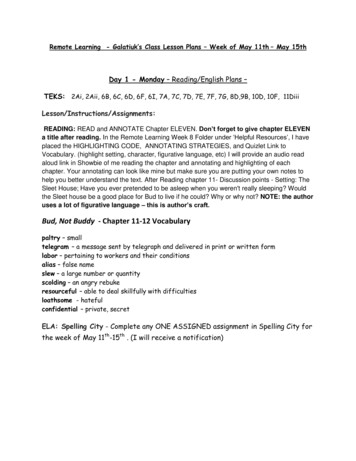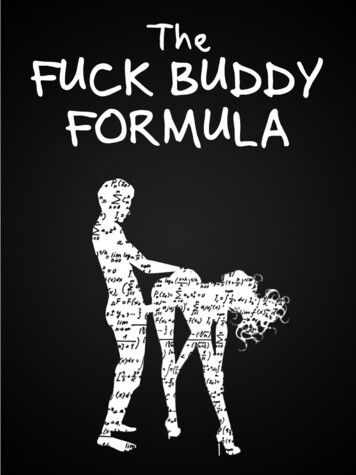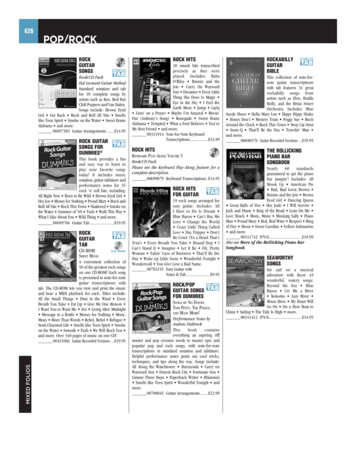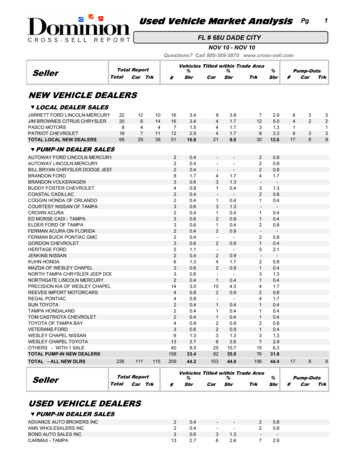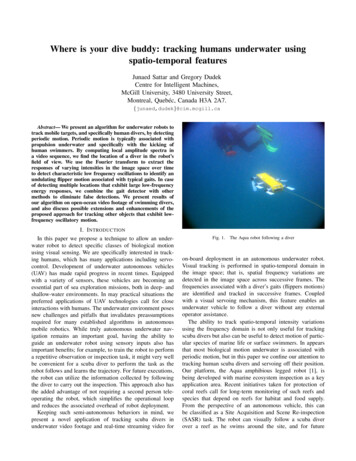
Transcription
Where is your dive buddy: tracking humans underwater usingspatio-temporal featuresJunaed Sattar and Gregory DudekCentre for Intelligent Machines,McGill University, 3480 University Street,Montreal, Quebéc, Canada H3A 2A7.{junaed,dudek}@cim.mcgill.caAbstract— We present an algorithm for underwater robots totrack mobile targets, and specifically human divers, by detectingperiodic motion. Periodic motion is typically associated withpropulsion underwater and specifically with the kicking ofhuman swimmers. By computing local amplitude spectra ina video sequence, we find the location of a diver in the robot’sfield of view. We use the Fourier transform to extract theresponses of varying intensities in the image space over timeto detect characteristic low frequency oscillations to identify anundulating flipper motion associated with typical gaits. In caseof detecting multiple locations that exhibit large low-frequencyenergy responses, we combine the gait detector with othermethods to eliminate false detections. We present results ofour algorithm on open-ocean video footage of swimming divers,and also discuss possible extensions and enhancements of theproposed approach for tracking other objects that exhibit lowfrequency oscillatory motion.I. I NTRODUCTIONIn this paper we propose a technique to allow an underwater robot to detect specific classes of biological motionusing visual sensing. We are specifically interested in tracking humans, which has many applications including servocontrol. Development of underwater autonomous vehicles(UAV) has made rapid progress in recent times. Equippedwith a variety of sensors, these vehicles are becoming anessential part of sea exploration missions, both in deep- andshallow-water environments. In may practical situations thepreferred applications of UAV technologies call for closeinteractions with humans. The underwater environment posesnew challenges and pitfalls that invalidates preassumptionsrequired for many established algorithms in autonomousmobile robotics. While truly autonomous underwater navigation remains an important goal, having the ability toguide an underwater robot using sensory inputs also hasimportant benefits; for example, to train the robot to performa repetitive observation or inspection task, it might very wellbe convenient for a scuba diver to perform the task as therobot follows and learns the trajectory. For future executions,the robot can utilize the information collected by followingthe diver to carry out the inspection. This approach also hasthe added advantage of not requiring a second person teleoperating the robot, which simplifies the operational loopand reduces the associated overhead of robot deployment.Keeping such semi-autonomous behaviors in mind, wepresent a novel application of tracking scuba divers inunderwater video footage and real-time streaming video forFig. 1.The Aqua robot following a diveron-board deployment in an autonomous underwater robot.Visual tracking is performed in spatio-temporal domain inthe image space; that is, spatial frequency variations aredetected in the image space across successive frames. Thefrequencies associated with a diver’s gaits (flippers motions)are identified and tracked in successive frames. Coupledwith a visual servoing mechanism, this feature enables anunderwater vehicle to follow a diver without any externaloperator assistance.The ability to track spatio-temporal intensity variationsusing the frequency domain is not only useful for trackingscuba divers but also can be useful to detect motion of particular species of marine life or surface swimmers. In appearsthat most biological motion underwater is associated withperiodic motion, but in this paper we confine our attention totracking human scuba divers and servoing off their position.Our platform, the Aqua amphibious legged robot [1], isbeing developed with marine ecosystem inspection as a keyapplication area. Recent initiatives taken for protection ofcoral reefs call for long-term monitoring of such reefs andspecies that depend on reefs for habitat and food supply.From the perspective of an autonomous vehicle, this canbe classified as a Site Acquisition and Scene Re-inspection(SASR) task. The robot can visually follow a scuba diverover a reef as he swims around the site, and for future
reinspections, make use of this information.The paper is organized in the following sections: inSec. II we look at related work in the domains of tracking,oriented filters and spatio-temporal pattern analysis in imagesequences, as well as underwater vision for autonomousvehicles. The Fourier energy-based tracking algorithm ispresented in Sec. III. Experimental results of running thealgorithm on video sequences are shown in Sec. IV. We drawconclusions and discuss some possible future directions ofthis work in Sec. V.II. R ELATED W ORKThe work presented in this paper combines previous workdone in different domains, and its novelty is in the use offrequency domain information in visual target recognitionand tracking. In the following paragraphs we consider someof the extensive prior work on tracking of humans in video,underwater visual tracking and visual serving in general.Our work in based on estimating amplitude spectra in thetemporal domain of live video. If the computational resourceswere available we might seek to estimate a full ensembleof patio-temporal orientations using a technique such as thewell-established steerable filter [2].Niyogi and Adelson have utilized spatio-temporal patternsin tracking human beings on land [3]. They look at thepositions of head and ankles, respectively, and detect thepresence of a human walking pattern by looking at a “braidedpattern” at the ankles and a straight-line translational patternat the position of the head. In their work, however, the personhas to walk across the image plane roughly orthogonal to theviewing axis for the detection scheme to work.Several researchers have looked into the task of trackinga person by identifying walking gaits. Recent advancementsin the field of Biometrics also have shown promise inidentifying humans from gait characteristics [4]. It appearsthat different people have characteristic gaits and it may bepossible to identify a person using the coordinated relationship between their head, hands, shoulder, knees, and feet.In a similar vein, several research groups have exploredthe detection of humans on land from either static visualcues or motion cues. Such methods typically assume anoverhead, lateral or other view that allows various body partsto be detected, or facial features to be seen. Notably, manytraditional methods have difficulty if the person is waklingdirectly way from the camera. In contrast, the present paperproposes a technique that functions without requiring a viewof the face, arms or hands (either of which may be obscuredin the case of scuba divers). In addition, in our particulartracking scenario the diver typically points directly awayfrom the robot that is following them.While tracking underwater swimmers visually have notbeen explored in the past, some prior work has been done inthe field of underwater visual tracking and visual servoingfor AUVs. Naturally, this is closely related to generic servocontrol. The family of algorithms developed are both of theoffline and on line variety. The on line tracking systems, inconjunction with a robust control scheme, provide underwater robots the ability to visually follow targets underwater [5].III. M ETHODOLOGYThe core of our approach is to use periodic motion asthe signature of biological propulsion and. specifically forperson-tracking, to use it to detect the kicking gait of a personswimming underwater. While different divers have distinctkicking gaits, the periodicity of swimming (and walking)is universal. Our approach, thus, is to examine the localamplitude spectra of the image in the frequency domain. Wedo this by computing a windowed Fourier transform on theimage to search for regions that have substantial band-passenergy at a suitable frequency. The flippers of a scuba divernormally oscillate at frequencies of between 1 and 2 Hz. Anyregion of the image that exhibits high energy responses inthose frequencies is a potential location of a flipper.The essence of our technique is therefore to convert avideo sequence into a sampled frequency-domain representation in which we accomplish detection, and then use theseresponses for tracking. To do thus, we need to sample thevideo sequence in both the spatial and temporal domain andcompute local amplitude spectra. This could be accomplishedvia an explicit filtering mechanism such as steerable filterswhich might directly yield the required bandpass signals.Instead, we employ windowed Fourier transforms on the selected space-time region which are, in essence 3-dimensionalblocks of data from the video sequence (a 2D region of theimage extended in time). In principle, one could directlyemploy color information at this stage as well, but bothdue to the need to limit computational cost as well as thethe low mutual information content between color channels(especially underwater), we perform the frequency analysison luminance signals only. The algorithm is explained infurther detail in the following subsections.A. Fourier TrackingThe core concept of the tracking algorithm presented hereis to take a time varying spatial signal (from the robot)and use the well-known discrete-time Fourier transform toconvert the signal from the spatial to the frequency domain.Since the target of interest will typically occupy only a regionof the image at any time, we naturally need to perform spatialand temporal windowing.The standard equation relating the spatial and frequencydomain is as follows.Z1x[n] X(ejω )ejω dω(1)2π 2πX(ejω ) Xx[n]e jωn(2)n where x[n] is a discrete aperiodic function, and X(ejω ) isperiodic with length 2π. Equation 1 is referred to as thesynthesis equation, and Eq. 2 is the analysis equation whereX(ejω ) is often called the spectrum of x[n]. The coefficientsof the converted signal correspond to the amplitude and phase
of complex exponentials of harmonically-related frequenciespresent in the spatial domain.For our application, we do not consider phase information,but look only at the absolute amplitudes of the coefficientsof the above-mentioned frequencies. The phase informationmight be useful in determining relative positions of theundulating flippers, for example. It might also be used toprovide a discriminate between specific individuals. Thisparticular work does not differentiate between the individualflippers during tracking. This also speeds up the detection ofhigh energy responses, at the expense of sacrificing relativephase information.In this paper we will consider only purely temporal gaitsignatures. That is, we approximate the person’s motion asdirectly away from or towards the camera over the samplinginterval used to compute the gait signal. In practice, the divermay often have a small lateral motion as well, but in theviscous underwater medium it appears this can be ignored.We comment further on this later on.To detect an oscillating object close to the frequency ofa scuba diver’s flippers, we search in small regions of theimage and compute the amplitude spectrum using a temporalwindow (since the diver may not remain in a region of theimage for very long). Spatial sampling is accomplished usinga Gaussian windowing function at regular intervals over theimage. The Gaussian is appropriate since it is well-knowto simultaneously optimize localization in both space andfrequency space. It is also a separable filter, making is computationally efficient. Note, as an aside, that some authorshave considered tracking using box filter for sampling andthese produce undesirable ringing in the frequency domain,which can lead to unstable tracking. Since we need a causalfilter in the temporal domain, we employ an exponentialweighting kernel. Thus the filter has good frequency domainproperties and it can be computed recursively making isexceedingly efficient.Since we are computing a purely temporal signal for theamplitude computation, we use a Gaussian kernel to computea weighted-mean intensity value at each sample location as afunction of time. We have one such signal going backwardsover time in each of these rectangular subwindows. This localsignal is windowed with an exponentially decaying windows(decaying backwards in time) to produce the windowedsignal used for frequency analysis. Each such signal providesan amplitude spectrum that can be matched to a profile ofa typical human gait. In principle matching these amplitudespectra to human gaits would be an ideal application fora statistical classifier trained on a large collection of humangait signals. In practice however, these human-associated signals appear to be easy to identify and an automated classifieris not currently being used. (In addition, the acquisition ofsufficient training data is a substantial challenge.)B. Using color cuesLike any feature-based detector or tracker, the spatiotemporal features used in our filter can sometimes providefalse detections, either responding to multiple cues in theenvironment or simply to the wrong cue. This can beparticularly true if the robot is swimming near the bottomof the ocean floor inhabited by coral reefs. Periodic motionof the robot (due to the robots propulsion system, strongsurge or current underwater) can also confuse the trackerby generating high responses low-frequency components.Likewise when used in terrestrial applications there may beperiodic structures in the environment (such as fences) orperiodic motion as the robot moves (especially for a walkingrobot like ours). To address such issues, we combine theoutput of the Fourier tracker with a supplementary trackingsystem for intensity targets, specifically a blob tracker [6]tuned to detect the color of the divers flippers. The blobtracker uses precomputed color threshold values to segmentportion of the image that falls within these thresholds.Regions that are common to both the color threshold trackerand the Fourier tracker are chosen as the diver’s location.Conversely, the Fourier tracker can be used as a weightingfunction for the blob tracker for flipper tracking, by helpingthe blob tracker track the blob with the proper frequencycharacteristics.IV. E XPERIMENTAL R ESULTSWe applied the proposed algorithm on video sequencesof divers swimming underwater in both open-water (ocean)and closed-water (pool) environments. Both types of videosequences are challenging due to the unconstrained motion ofthe target and the diver, and the poor imaging conditions (inthe open-water footage). The success rate of the tracker wasmeasured (successful versus failed tracking sequences) bothwith and without the aid of color cues for tracking flippers.Since the Fourier tracker looks backward in time every Nframes to find the new location of the diver, the output ofthe computed locations are only available every N frames,unlike the color blob tracker which finds the location of colorblobs matching the tuned parameters in every frame.For the open-sea video footage, we have tracked a diverswimming in front of the robot for a duration of approximately 3 minutes, or 180 seconds, at a frame rate of 29frames per second. The time window for the Fourier trackerfor this experiment is 15 frames, corresponding the 0.5seconds of footage. Each frame has dimensions 720 480pixels and each rectangular subwindow is 180 120 pixels
Fig. 2.Fourier tracking process outline.Fig. 3. Flipper tracker tracking diver’s flippers: Sequence 1. The circularmark on the heel of the left flipper is the target location determined by thesystem.in size (one-fourth in each dimension). The subwindowsoverlap each other by half the width and the height.Each subwindow is first blurred with a Gaussian having0 mean and 0.5 variance to remove high frequency noiseand artifacts. The average of the intensity values of eachsubwindow is calculated and saved in a time-indexed vector.At the end of frame 15, Fourier transforms are performedon each these vectors. The resulting FFT output with themaximum lowest frequency energy is chosen as the probablelocation of the diver.Figure 3 shows output of the Fourier tracker on one frameof a swimming diver sequence. The output of the trackeris shown by the red circular blob on the diver’s flippers.Fig. 4. FFT for the intensities in Fig. 3 Note the large low frequencyresponse.The absolute values of the amplitude spectrum from thissequence is shown in Fig. 4. Observe that the FFT outputis symmetric around the Nyquist frequency, and the DCcomponent of the amplitude spectrum has been eliminated.The low frequency components of the amplitude spectrumexhibit very high energy as expected around the region ofthe oscillating flippers. Since the video was shot at approximately 30 frames per second, but sub-sampled at 15 frameper second, the lowest frequency components correspondroughly to the frequency of 1Hz. This matches exactly withthe requirements for tracking flippers, and the FFT responsefor the shown sequence consolidates that concept.
Fig. 5.Blob tracker output for the sequence in Fig. 3.TABLE IR ESULTS OF STANDALONE F OURIER TRACKINGTotal Frames5400Tracker outputs360Successful Tracks288Error Rate20%The result of using the blob tracker to aid the Fouriertracker narrows down the probable positions of the flippers.The output of the blob tracker (tuned to yellow) can be seenin the binary image of Fig. 5. The white segments of theimage are the portions with color signature that falls withinthe thresholds of the flipper’s color. As can be seen, theblob tracker outputs two different blobs for both flippers,and one of them correspond exactly to the output from theFourier tracker. The results of the standalone Fourier trackerand combining the Fourier tracker with the color tracker areshown in Tab.I and Tab.II.V. D ISCUSSION AND C ONCLUSIONSIn this paper we propose a mechanism for tracking humansin applications were they are being followed by a robotand, as a result, their motion is largely along the viewingdirection of the robot. This configuration is especially illsuited to existing gait tracking mechanisms. In particular, weare interested in the specific problem of following a scubadiver with a mobile robot.TABLE IIR ESULTS OF F OURIER TRACKING WITH COLOR CUES[] Total Frames5400Tracker outputs360Successful Tracks352Error Rate2.2%Our approach is to exploit the periodic motion of humanlocomotion, and specifically kicking during swimming, toidentify a diver. This signal is extracted using a local spacetime filter in the frequency (Fourier) domain and, as a result,we call it a Fourier-tracker. It allows a human diver to bedetected and followed and, in practice, it is combined witha color blob tracker. By using a color/appearance signal incombination with the frequency-domain signal, we gain somerobustness to moments when the diver may stop kicking or insome way disturb the periodic signal. Likewise, the Fouriertracker makes the appearance signal much more robust toobjects in the environment that might cause errors (which isa particular problem on a coral reef where very diverse colorcombinations can occur).The work reported here suggests that this technique workswell, although the experiments have been conducted onstored data and have not yet been tested in a full closedloop tracking situation underwater (due to the serious complications and risks involved in a full experiment). Based onthese experimental results the system is being deployed forreal use now. For other applications it might be interesting toexamine cases where the target has a larger lateral motion.It appears that this could be naturally implemented usinga convolution-based filtering mechanism applied directly tothe image, as has been used in visual motion computation,but the computational overhead of such a procedure might begreater than what we propose here (and would thus probablybe outside the scope of what we can achieve on our testvehicle at present).R EFERENCES[1] G. Dudek, M. Jenkin, C. Prahacs, A. Hogue, J. Sattar, P. Giguère,A. German, H. Liu, S. Saunderson, A. Ripsman, S. Simhon, L. A.Torres-Mendez, E. Milios, P. Zhang, and I. Rekleitis, “A visually guidedswimming robot,” in IEEE/RSJ International Conference on IntelligentRobots and Systems, Edmonton, Alberta, Canada, August 2005.[2] W. T. Freeman and E. H. Adelson, “The design and use of steerablefilters,” Pattern Analysis and Machine Intelligence, IEEE Transactionson, vol. 13, no. 9, pp. 891–906, 1991.[3] S. A. Niyogi and E. H. Adelson, “Analyzing and recognizing walkingfigures in xyt,” in In Proceedings of IEEE Computer Society Conferenceon Computer Vision and Pattern Recognition, 1994, pp. 469–474.[4] M. S. Nixon, T. N. Tan, and R. Chellappa, Human Identification Basedon Gait, ser. The Kluwer International Series on Biometrics. SpringerVerlag New York, Inc. Secaucus, NJ, USA, 2005.[5] J. Sattar, P. Giguere, G. Dudek, and C. Prahacs, “A visual servoingsystem for an aquatic swimming robot,” in IEEE/RSJ InternationalConference on Intelligent Robots and Systems, Edmonton, Alberta,Canada, August 2005.[6] J. Sattar and G. Dudek, “On the performance of color tracking algorithms for underwater robots under varying lighting and visibility,”Orlando, Florida, May 2006.
(a) Fourier tracker output, sequence 2(b) Fourier tracker output, sequence 3(c) Spatio-temporal intensity variations, sequence 2(d) FFT output, sequence 2(e) Spatio-temporal intensity variations, sequence 3(f) FFT output, sequence 3Fig. 6.Fourier tracker operations for two consecutive sequences with intensity and corresponding frequency responses.
and tracking. In the following paragraphs we consider some of the extensive prior work on tracking of humans in video, underwater visual tracking and visual serving in general. Our work in based on estimating amplitude spectra in the temporal domain of live video. If the computational reso

